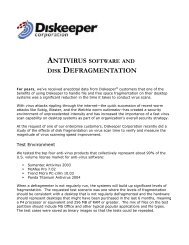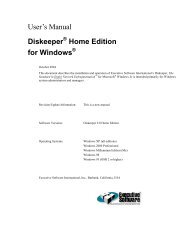Diskeeper 10 User's Manual
Diskeeper 10 User's Manual
Diskeeper 10 User's Manual
You also want an ePaper? Increase the reach of your titles
YUMPU automatically turns print PDFs into web optimized ePapers that Google loves.
44 <strong>Diskeeper</strong> Operation<br />
extra processing to further improve free space consolidation. It is important to note this method requires<br />
additional processing and time, and free space consolidation improvement will be gradual as the option is<br />
used over time. Since the Comprehensive Defragmentation method is best suited for scheduled<br />
defragmentation jobs, it is not available for <strong>Manual</strong> Defragmentation Jobs.<br />
In addition to these options, you can specify how <strong>Diskeeper</strong> handles large files. When the Efficiently<br />
defragment large files option is enabled, <strong>Diskeeper</strong> defragments large files only to the point where access time<br />
is improved and further defragmentation will not return a significant improvement. This can save considerable<br />
system resources and can significantly reduce the time to run a job.<br />
The Defragmentation Methods options are available within the Primary and Secondary Job Properties options<br />
described on page 43.<br />
To change the defragmentation method for <strong>Manual</strong> Defragmentation Jobs, click <strong>Manual</strong> Defragmentation Job<br />
Properties in the toolbar, then select Defragmentation Methods. Note the defragmentation method you<br />
set for <strong>Manual</strong> Defragmentation jobs will apply to all manual defragmentation jobs on all your volumes.<br />
To change the defragmentation method for Primary or Secondary defragmentation jobs, click Primary<br />
Defragmentation Job Properties or Secondary Defragmentation Job Properties in the<br />
toolbar,, select one or more volumes, then select Defragmentation Method.<br />
Note that the defragmentation method you set for Primary or Secondary defragmentation jobs will apply to all<br />
jobs of that type. For example, you can use the “Quick Defragmentation” method for all Primary<br />
Defragmentation Jobs, and use the “Comprehensive Defragmentation” method for your Secondary<br />
Defragmentation Jobs.<br />
Setting Disk and CPU Priority<br />
You can control the amount of disk input/output (I/O) and CPU resources used by <strong>Diskeeper</strong> for <strong>Manual</strong>,<br />
Primary and Secondary defragmentation jobs. For each of these job types, the Properties option allows you to<br />
control the disk and CPU priority.<br />
Running at the lowest CPU priority minimizes the system performance impact when <strong>Diskeeper</strong> is<br />
defragmenting a volume. However, defragmentation jobs running at the lowest priority can take substantially<br />
longer to complete than those running at higher priorities, since <strong>Diskeeper</strong> "backs off" for any process running<br />
at a higher priority (even screen savers). For this reason, you may have occasions where you want to run<br />
<strong>Diskeeper</strong> at a higher CPU priority. Keep in mind, though, that your system performance may be impaired<br />
when <strong>Diskeeper</strong> is run at higher priorities.<br />
In addition to the different levels of CPU priorities to choose from, <strong>Diskeeper</strong> also offers I/O Smart. This option<br />
takes the concept of run priorities one step farther by “throttling” (suspending) the defragmentation process<br />
whenever disk I/O activity is detected on a disk while it is being defragmented. This ensures the<br />
defragmentation process will be transparent to users, no matter how active the disk.<br />
To change the priority for <strong>Manual</strong> Defragmentation Jobs, click <strong>Manual</strong> Defragmentation Job Properties<br />
in the toolbar, then select Disk and CPU Priority. Note the disk and CPU priority properties you set for<br />
<strong>Manual</strong> Defragmentation jobs will apply to all manual defragmentation jobs on all your volumes.<br />
To change the priority for Primary or Secondary defragmentation jobs, click Primary Defragmentation Job<br />
Properties or Secondary Defragmentation Job Properties in the toolbar, select one or more<br />
volumes, then select Disk and CPU Priority.<br />
Note that the Disk and CPU Priority properties you set for Primary or Secondary defragmentation jobs will<br />
apply to all jobs of that type. For example, you can set the priority for all Primary Defragmentation Jobs to run






